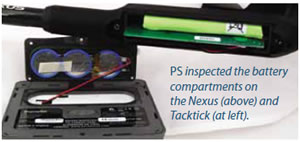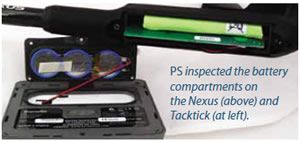
To wire, or not to wire? This is a good question, and there are certainly some pluses and minus to consider. For sailors with wiring-unfriendly masts, the wireless approach is a good one. These include wooden spars, ones with conduits that are already full with other wiring, and masts that are regularly unstepped. The downside of going wireless is that the batteries will need to be changed on occasion, and in some cases, signal interference is possible.
Testers looked closely at the Garmin/Nexus gWind/nWind and Raymarine Tackticks wind sensor batteries. The gWinds NiMH battery life is about three to four years, depending on usage; it is easy to replace and costs about $20. The Tacktick TA100s battery life, according to Raymarine, depends on usage. The replaceable lithium batteries cost about $65 and are fairly easy to install, but may require removal to allow easier access. All current Tacktick Micronet displays have replaceable batteries with an estimated 10-year life.
Wireless interference issues are possible in a few cases. The Tacktick system uses 916MHz for wireless data transmission. This is close to the frequencies of some GSM-based cellphones and other wireless devices such as PC keyboards/mouses and some hobbyist gear. The nWind/gWind system transmits at 2.4GHz. This frequency is also in the Bluetooth range along with some WiFi devices, cordless phones, and older microwave ovens.
Overall, reports of interference problems are few. Sailors should note that typically anything that conducts electrical current can act as a radio frequency block, and this can include sails with high carbon-fiber content.
Bottom line: For sailors who want wind data and have wiring-adverse spars, wireless is the way to go. On the whole, we had no issues with the tested wireless systems. Both promptly connected and worked well. The Tacktick display does need to have close to a line of sight location relative to the wind sensor. The Nexus/Garmin system offers additional flexibly because the wireless receivers location can be optimized. If you don’t need wireless capability, stay with the hardwired systems.




































